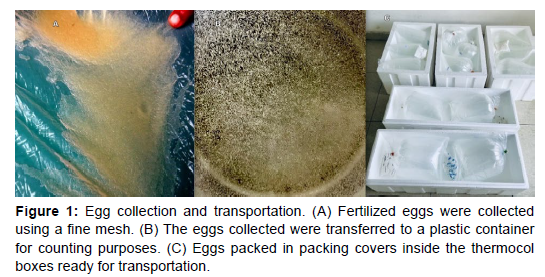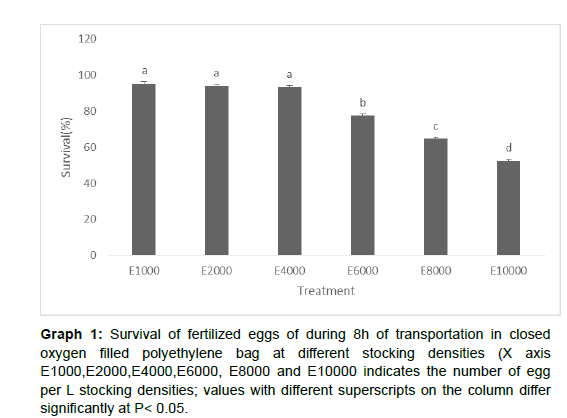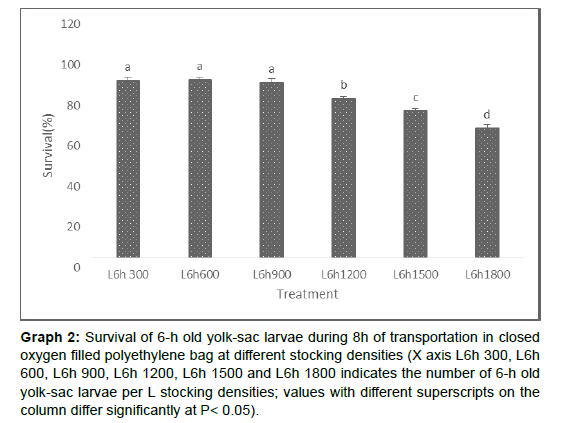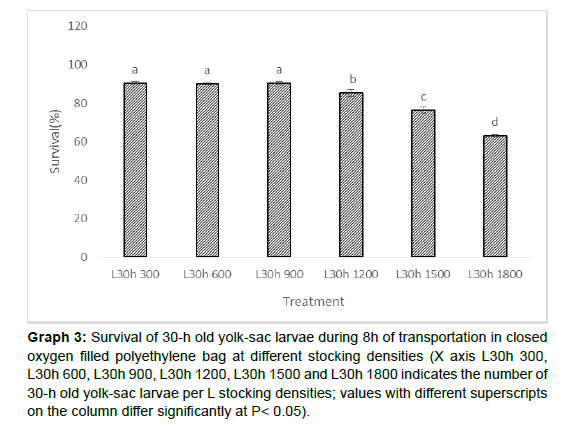OPTIMIZING TRANSPORTATION OF FERTILIZED EGGS AND YOLK SAC LARVAE OF SILVER POMPANO (TRACHINOTUS BLOCHII)
Received: 19-Jul-2023 / Manuscript No. JFLP-23-107246 / Editor assigned: 21-Jul-2023 / PreQC No. JFLP-23-107246(PQ) / Reviewed: 04-Aug-2023 / QC No. JFLP-23-107246 / Revised: 09-Aug-2023 / Manuscript No. JFLP-23-107246(R) / Accepted Date: 11-Aug-2023 / Published Date: 16-Aug-2023 DOI: 10.4172/2332-2608.1000441
Abstract
Fish seed transport is one of the significant activities in fish farming. The study optimised the packing density of eggs and yolk-sac larvae of Trachinotus blochii in closed plastic bags without using any tranquillizers. The post-shipment survival after railway shipment to varying distances was analyzed to optimize the stocking density. Six litres of seawater (of 34 ppt salinity) in a 32’ x 16.5’ polythene bag with 8-10 ppm oxygen concentration is used to transport various packing densities of egg and yolk-sac larvae. The results indicated that packing density and duration significantly influence survival rate during the transportation of fertilized yolk sac larvae of silver pompano. The optimum stocking density obtained for fertilized eggs (0 dph unhatched larvae) and 1st dph yolk sac larvae are 4100 ± 65.46 /L and 901.5 ± 33.58/L, respectively.
Keywords
Silver pompano; Transportation; Marine fish egg; Yolk sac larvae
Introduction
Transportation of early life stages and broodstock fishes from brood banks to hatcheries is an integral component of marine finfish aquaculture as the technology for breeding techniques is less familiar than in the case of freshwater. Shipment of hatchery-produced yolk-sac larvae from brood banks to other larval rearing facilities can be set free hatchery space to avail more viable broodstock and thereby increase the seed production. This may supplement the biosecurity level by reducing the imbrication of various life stages [1].
Considering the shipping of fertilized eggs, the most widely used one is Salmon [2], with literature focused mainly on the trout and salmon species. Gomes [3] provided information on the shipment of early stages of freshwater fish larvae, but this information is rarely available for potential tropical marine finfish species such as Pompano and Barramundi. The available literature has mainly dealt with the juvenile and early larval stages [4, 5].
A study on the early larval stages of marine finfish has been done in yolk-sac larvae of yellow fin tuna [5]. Shipment studies on the juvenile stages of Cobia (27 to 46 days dph) (Rachycentron canadum) were done by Steiglitz [6]. In contrast, the survival of 1.5gm to 3.0gm sized juveniles of Cobia was studied under simulated transport conditions by Colburn [7]. While, the first proposed reducing salinity while packing the cobia fingerlings in closed containers for improved stocking density and survival, the second study confirmed that shipment density should be below 20 kg/m3 for the same fish. In a study on the shipment of developed larval stages of Grouper, Estudillo and Duray [8] confirmed that the temperature, packing density and size of larvae will affect the total NH3 level, which will seriously affect the mortality rate of larvae. They have reported a packing density of 50 larvae/L for 45 – 60 day-old larvae.
Trachinotus blochii (Silver pompano or American pomfret) is a popular, commercial species which fetches a high demand and market price in the Indian subcontinent. Wild caught hatchery-reared (in 10- ton capacity recirculatory aquaculture systems) broodstock fishes of silver pompano were maintained in the Vizhinjam regional centre of ICAR-CMFRI, Kerala, India. Induced spawning of Silver Pompano was done using an analogue of luteinizing hormone-releasing hormone [LH-RHa des-Gly10 (D-Ala6) LH-RH ethyl amide, acetate salt].
The present investigation on the optimization of stoking density of eggs and yolk sac larvae during transportation has analysed the three different stocking densities of eggs and yolk sac larvae. The trials compared two stages of yolk sac larvae, 0 dph and 1st dph larvae, predominantly before and after hatching occur. Spawning occurred in fibreglass tanks with 34 ppt salinity, temperature 29℃, dissolved oxygen, 5.62 mg/L and pH 8±0.1. After spawning, fertilized eggs were collected, usually at the optic vesicle stage (around 8hrs of spawning) of the embryonic development using a 250 - 500 μ mesh cloth. Fertilized eggs are pelagic and can be collected by sieving the surface water column using a mesh cloth (Figure 1). Collected eggs were transferred into a 10L glass jar with seawater. After thoroughly mixing eggs, the average concentration can be measured using three volumetric sub-samples of 10 ml aliquots. For 1st dph larvae, the collected eggs were stocked in a 5-ton capacity fibreglass tank with filtered seawater, and the shipment trial had done only when it was completed 24 hrs after spawning.
Six litres of UV sterilized filtered seawater (of 34 ppt salinity) in 32’ x 16.5’ polythene bags (Metro Poly Industries, Kerala, India) with 8-10 mg/L (Hanna 98198- Dissolved oxygen meter, India) pure oxygen concentration is used for both shipment trials. The first trial compared three different stocking densities for 0 dph (SD: 2000/L, 4000/L, 6000/L) larvae, and the second trial studied the survival of three stocking densities of 1st dph larvae (1000/L, 2000/L, 3000/L). All the treatments were conducted in triplicate. Actual transport was conducted to Azhikod state pompano hatchery, Kerala (Train No. 16302 from Trivandrum Central Railway station to Ernakulam south railway station) to determine the optimum stocking densities for Silver pompano yolk sac larvae. This shipment included two-hour road travel and 6 hours of train parcel service. No tranquillizers were used for the shipment process. Mean water quality parameters in the bags upon closure were as follows: temperature 29.0 °C ± 0.94 °C; dissolved oxygen 11.20 mg/L ±2.11 mg/L; pH 8.11± 0.10. Desired shipping density was filled in each packet, and the air space above the water column in each packet was filled with pure oxygen before tying off each packet and the carton box. After reaching the destination, dissolved oxygen level, temperature and pH were not significantly different among trials. Graph 1 presents the survival of fertilized eggs of Silver pompano during 8 h transportation. Egg survival during transportation decreased with increase in stocking densities. Significantly (P< 0.05) higher survival was found at E1000, E2000, E4000 than that of E6000, E8000 and E10000. Survival (%) was not differed signicantly (P< 0.05) between E1000, E2000 and E4000.
Graph 1: Survival of fertilized eggs of during 8h of transportation in closed oxygen filled polyethylene bag at different stocking densities (X axis E1000,E2000,E4000,E6000, E8000 and E10000 indicates the number of egg per L stocking densities; values with different superscripts on the column differ significantly at P< 0.05.
Graph 2 shows survival of 6-h old yolk-sac larvae during 8h transportation in closed polythene bag at different stocking densities. Larval survival also followed the same trend that of egg, found decreased with increase in stocking densities. The survival was significantly (P< 0.05) higher at 300, 600, 900 nos/L stocking densities compared to that of 1200, 1500 and 1800 nos/L. However there were no significant difference between the survival of 6-h old yolk-sac larvae transported at 300, 600, 900 nos/L stocking densities.
Graph 2: Survival of 6-h old yolk-sac larvae during 8h of transportation in closed oxygen filled polyethylene bag at different stocking densities (X axis L6h 300, L6h 600, L6h 900, L6h 1200, L6h 1500 and L6h 1800 indicates the number of 6-h old yolk-sac larvae per L stocking densities; values with different superscripts on the column differ significantly at P< 0.05).
Graph 3 shows survival of 30-h old yolk-sac larvae during 8h transportation in closed polythene bag at different stocking densities.
Graph 3: Survival of 30-h old yolk-sac larvae during 8h of transportation in closed oxygen filled polyethylene bag at different stocking densities (X axis L30h 300, L30h 600, L30h 900, L30h 1200, L30h 1500 and L30h 1800 indicates the number of 30-h old yolk-sac larvae per L stocking densities; values with different superscripts on the column differ significantly at P< 0.05).
The survival (%) of 30-h old larvae was significantly (P< 0.05) higher at lower stocking densities such as 300,600 and 900 nos/L compared to that of 1200, 1500 and 1800 no/L. The survival (%) of 30h old yolk sac larvae were not differed significantly (P< 0.05) among the L30h 300, L30h 600 and L30h 900 treatments. The higher survival was 90%.
Conclusion
In conclusion, transport of the fertilised eggs of silver pompano was found to be appropriate for transportation with high packing densities. It is suggested that longer fertilized pompano egg transportation times can be studied in the future, with a focus on the scenario on the water quality parameters after the egg hatching occurred.
Acknowledgments
We are grateful to the Director and Head of the Mariculture Division for the support provided and the ICAR-funded project “All India Network Project on Mariculture” funding.
Data availability statement
The authors attest that the article contains the data needed to support the findings.
Ethical approval
All the experiments on live fish were conducted in compliance with ARRIVE guidelines (Percie du Sert 2020) and the procedures were approved by ICAR-CMFRI, Kochi.
Author contribution
Ambarish P Gop-Experimental design, Conducting experiments and Manuscript preparation.
Anil MK-Conception and design of the study.
Surya S-Ovarian biopsy of fishes and hormone inducement.
Santhosh B-Standardisation of hormone administration.
Gomathi P-Rearing of larvae.
F Muhammed Anzeer-Analysis of results.
Tanveer Hussain-Experiments on the survival of larvae.
Bobby Ignatius-Critical review of the manuscript.
Suresh VVR-Manuscript review.
Sudarsan KS-Manuscript review.
Gopalakrishnan-Final approval and review of the manuscript.
References
- Stuart K, Losordo M, Olin P, Drawbridge M (2013) Effects of stocking density and water conditioners on yolk‐sac larvae of two marine finfish during simulated air transport. Aquac Res 46: 2124-2132.
- Komrakova M, Holtz W (2009) Factors responsible for successful chilled storage of unfertilized rainbow trout (Oncorhynchus mykiss) eggs. Aquac 286: 156-163.
- Gomes LC, Roubach R, Araujo‐Lima CA, Chippari‐Gomes AR, Lopes NP, et al. (2007) Effect of fish density during transportation on stress and mortality of juvenile Tambaqui Colossoma macropomum. JWAS 34: 76-84.
- Stuart K, Losordo M, Olin P, Drawbridge M (2018) Optimizing procedures for shipping marine fish eggs using white seabass, Atractoscion nobilis, as a model.Aquac 493: 229-232.
- Zink IC, Benetti DD, Douillet PA, Margulies D, Scholey VP (2011) Improvement of Water Chemistry withBacillusProbiotics Inclusion during Simulated Transport of Yellowfin Tuna Yolk Sac Larvae.N Am J Aquac 73: 42-48.
- Stieglitz JD, Benetti DD, Serafy JE (2012) Optimizing transport of live juvenile cobia: effects of salinity and shipping biomass. Aquac 364: 293-297.
- Colburn HR, Walker AB, Berlinsky DL, Nardi GC (2008) Factors affecting the survival of cobia, Rachycentron canadum, during simulated transport. JWAS 39: 678-683.
- Estudillo CB, Duray MN (2003) Transport of hatchery-reared and wild grouper larvae, Epinephelus sp. Aquac 219: 279-290.
Indexed at, Google Scholar, Crossref
Indexed at, Google Scholar, Crossref
Indexed at, Google Scholar, Crossref
Indexed at, Google Scholar, Crossref
Citation: Gop AP, Anil MK, Surya S, Santhosh B, Gomathi P, et al. (2023)Optimizing Transportation of Fertilized Eggs and Yolk Sac Larvae of SilverPompano (Trachinotus Blochii). J Fisheries Livest Prod 11: 441. DOI: 10.4172/2332-2608.1000441
Copyright: © 2023 Gop AP, et al. This is an open-access article distributed underthe terms of the Creative Commons Attribution License, which permits unrestricteduse, distribution, and reproduction in any medium, provided the original author andsource are credited.
Share This Article
Recommended Journals
Open Access Journals
Article Tools
Article Usage
- Total views: 1291
- [From(publication date): 0-2023 - Mar 29, 2025]
- Breakdown by view type
- HTML page views: 1052
- PDF downloads: 239




